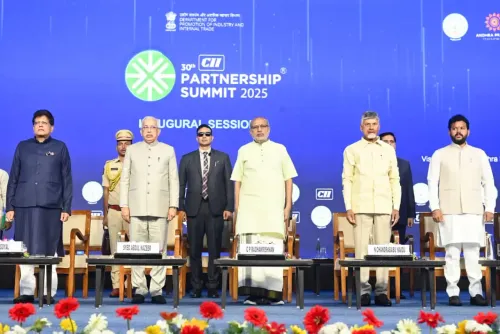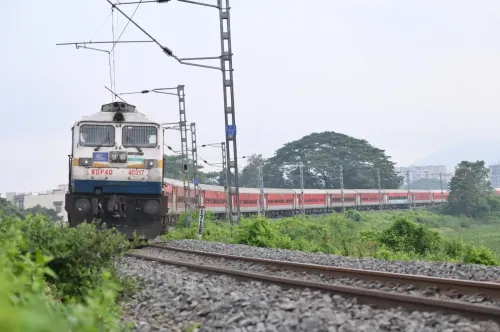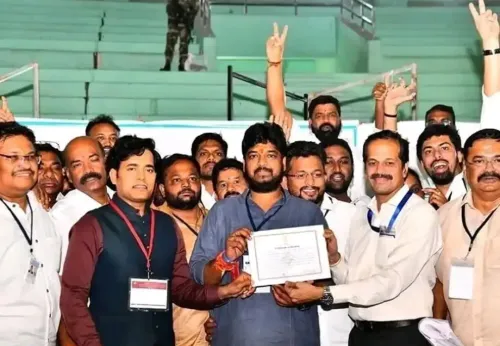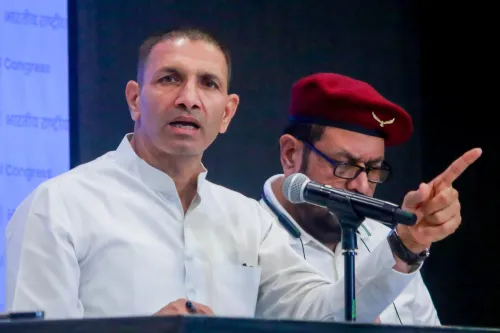What Factors Led to the NDA's Dominance in the Bihar Assembly Elections?

Synopsis
Key Takeaways
- NDA surpassed 200 seats in the Bihar Assembly elections.
- Women voters played a crucial role in the NDA's victory.
- The opposition faced a historic decline, with less than 40 seats.
- Effective welfare programs resonated with voters, overshadowing anti-incumbency.
- The outcome reinforces PM Modi's appeal in the Hindi heartland.
Patna, Nov 14 (NationPress) The Bihar Assembly elections resulted in one of the most significant outcomes in the state’s electoral history, with the National Democratic Alliance surpassing the 200-seat threshold in the 243-member House, achieving a commanding majority that overshadows its 125-seat win in 2020.
As the counting unfolded throughout the afternoon, the NDA's seat count fluctuated between 200-208, bolstered by the Bharatiya Janata Party claiming the title of the largest party with leads in 90-95 constituencies. Nitish Kumar's Janata Dal (United) followed closely with 79-84 seats, while Chirag Paswan's Lok Janshakti Party (Ram Vilas) garnered 20-22, and smaller coalitions like Hindustani Awam Morcha and Rashtriya Lok Morcha added another 8-10.
The opposition coalition, Mahagathbandhan, faced a historic decline, securing fewer than 40 seats. The Rashtriya Janata Dal managed to hold onto 26-36, with Congress suffering a dismal drop to only 4-5 seats, and Left parties barely achieving a few victories. Voter turnout reached a remarkable 67.13 percent, nearly ten points higher than in 2020, yet this uptick signified a preference for continuity over change.
This electoral blowout provides significant insights into Bihar’s complex political landscape and impacts national politics.
The outcome exemplifies how disciplined coalitions, effective welfare strategies, and caste management can transform modest vote shares into overwhelming majorities in India's first-past-the-post electoral framework, while fragmentation and narrative missteps can devastate even established opposition groups.
Nitish Kumar emerges as the undeniable titan of Bihar politics, ready to embark on a tenth term as Chief Minister, solidifying his status as the state's most resilient leader since independence.
Despite murmurs of fatigue after two decades in governance and numerous alliance shifts, Kumar's personal popularity—rooted in prohibition, restoration of law and order, and women-focused initiatives—remained steadfast.
Older female voters in rural areas frequently cited free rations, Jeevika groups, and the transition from bicycles to scooters as key reasons for their loyalty, aiding the JD(U) in significant gains within its EBC-Mahadalit strongholds.
The NDA's effective consolidation minimized the functional number of parties to below 2.7, converting a 10-11 point vote advantage into a margin exceeding 160 seats.
Women voters played a pivotal role, with their turnout showing a distinct female bias, resulting in overwhelming NDA victories in regions like Mithila, Kosi, and Magadh.
Incentives such as 10,000 rupee grants, self-help group connections, and safety initiatives resonated significantly more than Tejashwi Yadav's job promises, highlighting how targeted welfare can counteract anti-incumbency in a state grappling with stark developmental deficits.
The Mahagathbandhan's once-effective caste calculations collapsed dramatically as the NDA executed superior social engineering.
While the RJD retained its core Yadav-Muslim support, the alliance struggled to broaden its reach into non-Yadav OBCs and EBCs, where Nitish's micro-caste outreach and Chirag Paswan's Paswan consolidation penetrated deeply.
Notably, the NDA made strides into the Muslim-majority Seemanchal area, fielding and winning with Muslim candidates in 10-12 seats, breaking the opposition's monopoly.
The AIMIM’s unexpected haul of 5-6 seats further fragmented minority votes, proving detrimental in several tight races. Congress experienced its worst-ever showing in Bihar, securing only four seats out of 61 contested and dragging the entire coalition down with a strike rate below 7 percent.
Internal disputes over seat allocations, a lack of prominent campaign figures, and an inability to counter the BJP’s assertive narratives transformed the historic party into a liability rather than an asset, raising serious questions about its future role within the INDIA bloc.
Vote-splitting entities like Prashant Kishor's Jan Suraaj, which garnered a commendable 3.5 percent but secured no seats, and AIMIM's 1.4 percent, inadvertently aided the NDA by diminishing Mahagathbandhan margins without establishing viable alternatives.
Kishor's highly publicized grassroots padyatra achieved moral victories in urban zones but highlighted the limitations of consultant-driven politics against entrenched caste-welfare networks.
The opposition's campaign, heavily focused on unemployment commitments and conspiracy theories surrounding voter lists, failed to undermine the NDA's development narrative anchored in central schemes and Nitish's reputation for governance.
Tejashwi Yadav's dynamic rallies invigorated youth engagement but could not surpass the alliance’s defensive approach and credibility gaps regarding governance. For national politics, Bihar 2025 reinforces PM Modi's sustained appeal in Hindi heartland states and affirms the BJP's strategy of supporting regional leaders like Nitish while expanding its own presence.
For the opposition, this serves as a harsh reality check: without stringent alliance discipline, credible governance alternatives, and a unified narrative, the INDIA Bloc risks becoming obsolete ahead of upcoming electoral challenges.
As celebrations erupt across NDA camps and stunned silence envelops opposition offices, one truth becomes unmistakable: Bihar has unequivocally opted for stability over experimentation, welfare over empty promises, and Nitish Kumar's proven leadership over untested options.









